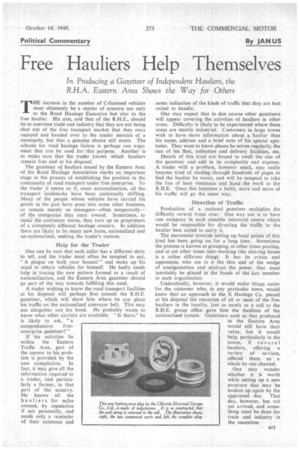Free Hauliers Help Themselves
Page 45

If you've noticed an error in this article please click here to report it so we can fix it.
In Producing a Gazetteer of Independent Hauliers, the R.H.A. Eastern Area Shows the Way for Others
THE increase in the number of C-licensed vehicles must ultimately be a matter of concern not only to the Road Haulage Executive but also to the free haulier. His aim, and that of the R.H.E., should be to convince trade and industry that they are not being shut out of the free transport market that they once enjoyed and handed over to the tender mercies of a monopoly, but that a genuine choice still exists. The scheme for road haulage liaison is perhaps one argument that can be used for this purpose. Another is to make sure that the trader knows which hauliers remain free and at his disposal.
The gazetteer of hauliers issued by the Eastern Area of the Road Haulage Association marks an important stage in the process of establishing the position in the community of road transport under free enterprise. To the trader it seems as if, since nationalization, all the transport landmarks have been continually shifting. Many of the people whose vehicles have carried his goods in the past have gone into some other business, or remain merely as managers—often temporarily— of the companies they once owned. Sometimes, to make the confusion worse, they turn up as proprietors of a completely different haulage concern. In addition tbere are likely to be many new faces, nationalized and un-nationalized, seeking the trader's custom.
Help for the Trader One can be sure that each caller has a different story to tell, and the trader must often be tempted to say, "A plague on both your houses!" and make up his mind to obtain vehicles for himself. He badly needs help in tracing the new pattern formed as a result of nationalization, and the Eastern Area gazetteer should go part of the way towards fulfilling this need.
A trader wishing to know the road transport facilities at his disposal will perhaps first consult the R.H.E. gazetteer, which will show him where he can place his traffic on the nationalized conveyor belt. This may not altogether suit his book. He probably wants to know what other carriers are available. "Is there," he is likely to ask, "a comprehensive freeenterprise gazetteer? '
If his activities lie within the Eastern Traffic Area, part of the answer to his problem is provided by the new compilation, In fact, it may give all the information required to a trader, and particularly a farmer, in that part of the country. He knows all the hauliers for miles around, by reputation if not personally, and needs only a reminder of their existence and some indication of the kinds of traffic that they are best suited to handle.
One may expect that in due course other gazetteers will appear covering the activities of hauliers in other areas. Difficulty is likely to be experienced where these areas are mainly industrial. Customers in large towns wish to have more information about a haulier than his name, address and a brief note of his special aptitudes. They want to know places he serves regularly, the size of his fleet, collection and delivery facilities, etc.
Details of this kind are bound to swell the size of the gazetteer and add to its complexity and expense. A trader with a problem, however small, may easily become tired of reading through hundreds of pages to find the haulier he wants, and will be tempted to take the line of least resistance and hand the work to the R.H.E. Once this becomes a habit, more and more of his traffic will go the same way.
Direction of Traffic
Production of a national gazetteer multiplies the difficulty several times over. One way out is to have one company in each sizeable industrial centre which would be responsible for directing the traffic to the haulier best suited to carry it.
The movement towards.setting up focal points of this kind has been going on for a long time. Sometimes the process is known as grouping, at other times pooling, and at yet other times inter-working (the clearing house is a rather different thing), It has its critics and opponents, who see in it the thin end of the wedge of amalgamation and mistrust the power that must inevitably be placed in the hands of the key member in each organization.
Undoubtedly, however, it would make things easier for the customer who, in any particular town, would know that an approach to the X Haulage Co. placed at his disposal the resources of all or most of the *free hauliers in the locality, just as surely as a call to the R.H.E. group office gave him the facilities of the nationalized system. Gazetteers such as that produced in the Eastern Area would still have their value, but it would help, particularly in the towns, if sev er al hauliers, offering a variety of services, offered them as a whole by one channel.
One may wonder whether it is worth while setting up a new structure that may be broken up again by the appointed day. That day, however, has not yet arrived, and something must be done for trade and industry in the meantime.




























































































